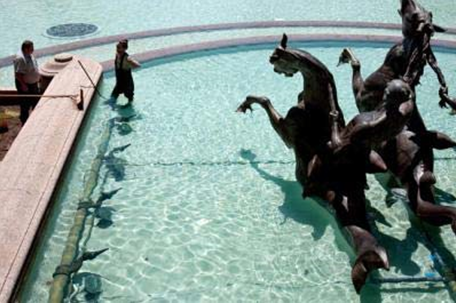Published 7 Sep 2012 at 12:53 AM
By Stuart Railey

Fountains, graffiti and a few dozen turtles may seem like they have nothing in common, but that’s only in the eyes of a student. In the uncommon eyes of the fountain maintenance crew, Zone 4, these seemingly unrelated words could be the bread and butter of any given workday.
To most, Zone 4 might sound strangely reminiscent of SEAL Team 6. Although these two specialized task forces may not be direct equivalents, they certainly have their similarities. This group of experienced fountain fanatics handles not one, not two, but yes, 11 different water displays around the campus. Charlie Cromartie, supervisor of South Campus Maintenance, oversees 20 employees, all of whom thwart the tyranny of algae, vandalism and faulty pipes while protecting the freedom-loving, reptilian citizens of Turtle Pond.
Thanks to Zone 4 and several other dedicated teams at Facilities Services, the University of Texas boasts a stunning campus. Lavish displays of florae are scrupulously maintained on every square inch of the property, beautiful Spanish barrel tile decorates the center campus buildings and a golden trimmed Texas Tower looks out protectively over the grounds.
The Littlefield Fountain, a familiar frontispiece of Texas’ college brochures, fits right in with this reputation of opulence. Sitting directly in front of the tower and six pack, water cascades from the two top tiers into a lower basin while jets project a series of steady streams over the wild cavalry of the sculpture. As the fall semester starts here, however, students will notice that Littlefield is in fact the only fountain that seems to be switched on. Since money is still flowing here at UT, the more cantankerous students may want to know why the fountains aren’t flowing as well.
By switching off the fountains here on school grounds, 300,000 gallons of water are saved each month, according to Laurie Lentz, the communications coordinator at UT’s Facilities Services. In layman’s terms, 200,000 toilet flushes are avoided every 30 days.
During the hottest weeks of the year, drought conditions are abated by restricting the use of water on both public and private property in Austin. With Stage 2 Water Use Restrictions taking effect this past Tuesday, the fountains remain an impractical, let alone expensive, use of the available water. Although each of the fountains is capable of recirculating, heat causes most of that water to evaporate, necessitating constant refills.
For typical homeowners in the Austin area of Travis County, sprinklers can only be used at times of the day when the temperature is low enough to avoid this evaporation. The University of Texas is not a homeowner, however, nor is it typical. The school is actually so atypical that it is not required to follow water restrictions imposed by the city. During the Gone to Texas rally Aug. 28, Littlefield Fountain was turned on at full pressure without needing the consent of city administration, since restrictions function more like guidelines than anything else.
In many parts of the world, water scarcity is an increasingly problematic and life-threatening circumstance for millions of people. Limited and restricted resources are a common motif of conflict abroad and at home. With these considerations in mind, UT stands proudly behind its motto: “What starts here changes the world.” Turning off the fountains mirrors the school’s successful zeroscaping initiative and general cutbacks in irrigation. Since the launch of a water recovery program 30 years ago, water has been collected from multiple sources and reused to help supplement losses in the cooling towers. As of 2011, treated water from sewage plants is now being pumped through the sprinkler systems (the toilet flushes weren’t a joke).
But will these fountains remain arid relics from a bygone age of unchecked water consumption?
The future of the fountains is not something that has come up often, explains Lentz. For now, dry season happens to be a welcome convenience for Zone 4 workers. After the LBJ fountain was drained last spring, a leak was discovered and subsequently fixed. Until the fate of these displays is determined, Zone 4 will continue to work hard at a job they enjoy and a school they love.
